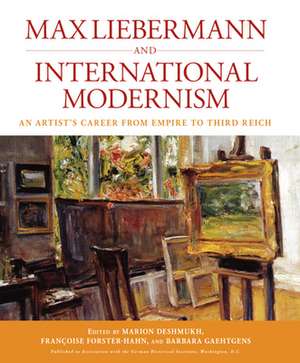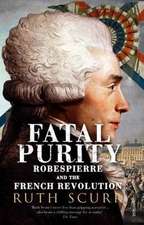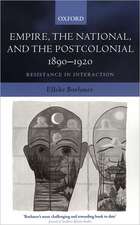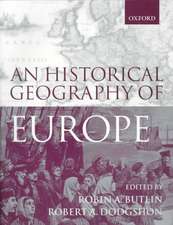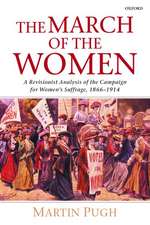Max Liebermann and International Modernism: Studies in German History, cartea 14
en Limba Engleză Paperback – 30 apr 2011
Din seria Studies in German History
- 14%
 Preț: 690.86 lei
Preț: 690.86 lei - 28%
 Preț: 474.21 lei
Preț: 474.21 lei - 14%
 Preț: 691.62 lei
Preț: 691.62 lei - 30%
 Preț: 584.00 lei
Preț: 584.00 lei - 30%
 Preț: 497.19 lei
Preț: 497.19 lei - 25%
 Preț: 516.71 lei
Preț: 516.71 lei - 25%
 Preț: 582.93 lei
Preț: 582.93 lei - 14%
 Preț: 920.72 lei
Preț: 920.72 lei - 9%
 Preț: 249.75 lei
Preț: 249.75 lei -
 Preț: 225.08 lei
Preț: 225.08 lei - 17%
 Preț: 581.72 lei
Preț: 581.72 lei - 13%
 Preț: 645.95 lei
Preț: 645.95 lei - 25%
 Preț: 522.99 lei
Preț: 522.99 lei -
 Preț: 189.89 lei
Preț: 189.89 lei - 26%
 Preț: 559.65 lei
Preț: 559.65 lei - 23%
 Preț: 748.38 lei
Preț: 748.38 lei -
 Preț: 154.49 lei
Preț: 154.49 lei -
 Preț: 301.38 lei
Preț: 301.38 lei -
 Preț: 301.00 lei
Preț: 301.00 lei -
 Preț: 264.26 lei
Preț: 264.26 lei - 23%
 Preț: 749.64 lei
Preț: 749.64 lei - 23%
 Preț: 751.25 lei
Preț: 751.25 lei - 23%
 Preț: 750.76 lei
Preț: 750.76 lei - 15%
 Preț: 577.08 lei
Preț: 577.08 lei - 23%
 Preț: 753.11 lei
Preț: 753.11 lei - 17%
 Preț: 582.61 lei
Preț: 582.61 lei - 12%
 Preț: 617.12 lei
Preț: 617.12 lei - 23%
 Preț: 744.71 lei
Preț: 744.71 lei - 23%
 Preț: 836.65 lei
Preț: 836.65 lei - 23%
 Preț: 753.18 lei
Preț: 753.18 lei - 23%
 Preț: 749.91 lei
Preț: 749.91 lei -
 Preț: 260.19 lei
Preț: 260.19 lei - 23%
 Preț: 749.32 lei
Preț: 749.32 lei -
 Preț: 258.66 lei
Preț: 258.66 lei - 23%
 Preț: 750.08 lei
Preț: 750.08 lei - 23%
 Preț: 835.31 lei
Preț: 835.31 lei - 23%
 Preț: 806.85 lei
Preț: 806.85 lei - 23%
 Preț: 749.77 lei
Preț: 749.77 lei -
 Preț: 264.82 lei
Preț: 264.82 lei - 23%
 Preț: 1002.27 lei
Preț: 1002.27 lei -
 Preț: 258.50 lei
Preț: 258.50 lei - 23%
 Preț: 749.32 lei
Preț: 749.32 lei -
 Preț: 261.93 lei
Preț: 261.93 lei - 23%
 Preț: 750.49 lei
Preț: 750.49 lei
Preț: 533.14 lei
Nou
Puncte Express: 800
Preț estimativ în valută:
102.01€ • 106.51$ • 84.43£
102.01€ • 106.51$ • 84.43£
Carte tipărită la comandă
Livrare economică 04-18 aprilie
Preluare comenzi: 021 569.72.76
Specificații
ISBN-13: 9781845456627
ISBN-10: 1845456629
Pagini: 266
Ilustrații: 113 ills
Dimensiuni: 213 x 277 x 20 mm
Greutate: 0.89 kg
Ediția:Firsttion
Editura: BERGHAHN BOOKS INC
Seria Studies in German History
ISBN-10: 1845456629
Pagini: 266
Ilustrații: 113 ills
Dimensiuni: 213 x 277 x 20 mm
Greutate: 0.89 kg
Ediția:Firsttion
Editura: BERGHAHN BOOKS INC
Seria Studies in German History
Notă biografică
Marion Deshmukh is the Robert T. Hawkes Professor of History at George Mason University where she served as Department Chair from 1984 to 1995 and from 2006 to 2007. Her publications include works and exhibition catalog essays on Max Liebermann, on German academies and art unions, on Berlin's National Gallery of Art since 1945 and on East German painters since 1990. She curated a Max Liebermann graphics show at the Goethe-Institut, Washington, DC (Max Liebermann, Works on Paper, 2006) and an exhibit, co-curated with the Wende Museum, also at the Goethe Institut, (Iconoclash! Political Imagery from the Berlin Wall to German Unification, 2009-10). Francoise Forster-Hahn is Distinguished Professor of the History of Art at the University of California, Riverside. She is the editor of Imagining Modern German Culture, 1889-1910 (1996) and the author of Max Beckmann in Kalifornien: Exil, Erinnerung und Erneuerung (2007). Her publications include numerous essays and contributions to books and exhibition catalogues on issues of nineteenth and twentieth century art and the role of institutions and exhibition displays in the formation of national and cultural identity. She is currently preparing a publication on the role of Berlin's Jahrhundertausstellung (1906) and Julius Meier-Graefe's Entwicklungsgeschichte der modernen Kunst (1904) in the construction of the history of modern art. Barbara Gaehtgens is an art historian, specializing in 17th Century Dutch and French art, 18th Century art theory and 19th Century German and American art. She has taught at the Technische Universitat Berlin and Princeton University and has been affiliated as a scholar with CASVA, Washington, National Gallery of Art, the Centre Allemand d'histoire de l'art in Paris and the Getty Research Institute in Los Angeles. Her numerous publications include Adriaen van der Werff, 1659-1722 (1987), Max Liebermann. Holland als Vorbild in exh. cat. Max Liebermann-Jahrhundertwende, Nationalgalerie Berlin (1997), Genremalerei. Theorie der klassischen Bildgattungen (2003) and Richelieu patron des arts (2009). Her present research centers on 17th Century French political iconography.
Cuprins
List of Illustrations Acknowledgements Introduction PART I: LIEBERMANN'S INTERNATIONAL CONNECTIONS AND TRAINING Chapter 1. Internationalism for the Nation: Max Liebermann as a Cultural Politician Peter Paret Chapter 2. Weimar Beginnings: Liebermann and Munkacsy Hendrik Ziegler Chapter 3. Liebermann's Holland Holly Richardson PART II: THE FRENCH CONNECTION Chapter 4. German Impressionism? Thomas Gaehtgens Chapter 5. Liebermann and Millet Andrea Meyer Chapter 6. Liebermann and his French Critics: Art and Politics from the 1870s to the 1930s Mathilde Arnoux Chapter 7. Max Liebermann's Art Collection: A Reconstruction from Letters and Documents Annegret Janda Chapter 8. History and Modernity: Liebermann's Late Garden Paintings Barbara Gaehtgens PART III: GERMAN CULTURAL CRITICISM Chapter 9. Criticism, Conflict and Controversy Matthias Eberle Chapter 10. How Modern is Modern? Max Liebermann and the Discourses of Modernism in 1906 Francoise Forster-Hahn Chapter 11. Who's Afraid of Delilah? Liebermann Portraying Women Margreet Nouwen Chapter 12. Kreigszeit and the Discourse of War Imagery Timothy Benson PART IV: INTERNATIONAL POLITICS AND INTERNATIONAL MODERNISM Chapter 13. Max Liebermann's Role in Russia Marina Dmietreva-Einhorn Chapter 14. Paintings and Drawings by Max Liebermann: A British Intervention against European Fascism Susan M. King Chapter 15. The Art of the Deal, Collecting Max Liebermann in America Christopher With Chapter 16. Sonderwege Historical and Art Historical: The Case of Max Liebermann Marion Deshmukh Chronological Timeline Notes on Contributors Bibliography Index
